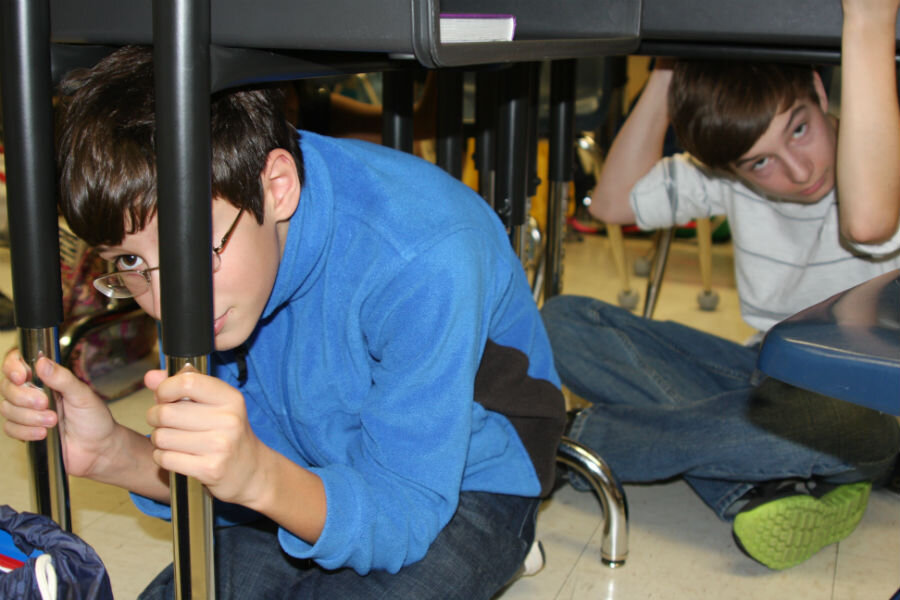Earthquake map: 42 states stand 'reasonable chance' of temblors
Earthquakes can happen anywhere. While most Americans associate quake hazards with the West Coast, one-third of the states in the nation face a “relatively high likelihood of experiencing damaging ground shaking,” according to a new report from the US Geological Survey.
The latest national seismic hazard map from the USGS, released Thursday, lends a more nuanced view to earthquake risks across the country than ever before, thanks to new advances in sensing instruments, modeling technology, and data analysis tools, says Mark Petersen, chief of the USGS National Seismic Hazard Mapping Project.
The new map includes heightened hazard levels for eastern states, the West Coast, and the central US. This reflects a better understanding of risks, not an actual increase of threat, Mr. Petersen stresses. In a few isolated places, namely New York City and Irvine, Oakland, and Santa Barbara, Calif., newly available data have led to reduced threat levels. The new data do not include risk assessment for earthquakes that some experts say may be caused by deep-well injection or hydraulic fracturing.
The report singles out 16 states that are considered high-risk: Alaska, Arkansas, California, Hawaii, Idaho, Illinois, Kentucky, Missouri, Montana, Nevada, Oregon, South Carolina, Tennessee, Utah, Washington, and Wyoming. That designation may not come as a surprise to residents of many of those states, with the exception of South Carolina, where a major quake has not occurred since 1886.
However, what’s more surprising is how pervasive relative risk is throughout the country. The USGS reports that 42 of the 50 states have a “reasonable chance” of experiencing ground-shaking in the next 50 years. Mr. Petersen suggests that these states should take that risk seriously.
“It's important that people consider the hazard that they face,” Petersen says. “This might be low on the list of priorities for some places, but it’s important when the consequences of inaction are very high.”
While residents of high-risk areas along the West Coast, Utah, and near the New Madrid fault in Minnesota tend to be aware of the hazards associated with tremors, in other parts of the country, particularly along the East Coast, earthquakes aren’t necessarily on people’s radar – even in places that have experienced devastating historic quakes.
In 1775, a tremor that was likely a Magnitude 6 earthquake (the Richter scale used to measure a quake’s intensity was not introduced until 1935) rocked Cape Ann, Mass., and caused extensive damage in Boston. The shock of that quake reverberated as far north as Nova Scotia and as far south as the Chesapeake Bay.
A century later, an even larger quake hit South Carolina, killing 83 people within the municipal boundaries of Charleston, and likely as many more residents living in the countryside, says social historian Richard Côté.
Despite numerous firsthand accounts in historic newspapers detailing the havoc and devastation caused by the Magnitude 7.3 quake, many residents in South Carolina are unaware of the risks posed by local seismic activity, says Mr. Côté, who took on the self-appointed role of “earthquake preparedness evangelist” after conducting several years of research into the 1886 Great Charleston Earthquake.
“People tend forget about these quakes,” Petersen says.
On Aug. 23, 2011, a Magnitude 5.8 earthquake in rural Virginia caught much of the East Coast off guard. That quake was felt by tens of millions of people up and down the Eastern seaboard, Petersen says. The last time a significant quake occurred in the Central Virginia Seismic Zone was 1875, illustrating the fact that just because a quake has not occurred in a very long time does not mean that another one will not occur in the future.
“I don’t want to be an alarmist in all of this and make people feel like they need to panic or anything,” Peteresen says. He subsequently added that he hopes that urban planners and builders will use the new USGS map and urban hazard maps that he expects to emerge during the next several years to fortify historic buildings.
“If you don’t prepare your buildings, then you might pay a high cost later if the earthquake does occur,” Petersen says.






